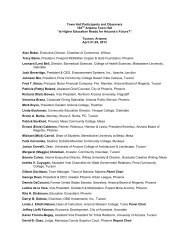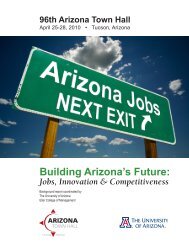Background Report - Arizona Town Hall
Background Report - Arizona Town Hall
Background Report - Arizona Town Hall
Create successful ePaper yourself
Turn your PDF publications into a flip-book with our unique Google optimized e-Paper software.
esources, education, research, and public programs. NEH grants typically go to<br />
cultural institutions, such as museums, archives, libraries, colleges, universities, public<br />
television, and radio stations, and to individual scholars. NEH grants strengthen<br />
teaching and learning in the humanities in schools and colleges across the nation,<br />
facilitate research and original scholarship, provide opportunities for lifelong learning,<br />
preserve and provide access to cultural and educational resources, and strengthen the<br />
institutional base of the humanities<br />
Otis <strong>Report</strong> on the Creative Economy of the Los Angeles Region: The Power of Art and Artists<br />
(Los Angeles: Otis College of Art and Design, 2010). This is the fourth Otis report (the first<br />
was in 2007): http://www.otis.edu/creative_economy/<br />
The NEA blog on the Otis report headlined: “Creativity is Serious Business.”<br />
http://www.arts.gov/artworks/?p=4937<br />
Using 2009 data, the report demonstrates once again that creativity is serious business<br />
in Southern California. Even in these challenging economic times, the creative<br />
economy is one of the largest business sectors in the region, second only to tourism<br />
and hospitality. In 2009, the arts, design, and entertainment industries together<br />
supported one in six jobs in the area, generated $127 billion in sales revenues, and<br />
were the source of $4.6 billion in state and local tax revenues. These regional<br />
findings make a national case. They put real numbers to the economic contributions of<br />
creative professionals and enterprises. Furthermore, the Otis <strong>Report</strong> data affirm that<br />
the 21st century is an age of ideas, in which creativity provides a long-range and<br />
sustainable competitive edge for the U.S. economy. Despite manufacturing downturns<br />
due largely to regional outsourcing of low-skill jobs, creative sector employment is<br />
projected to grow faster than in other sectors over the next five years and especially<br />
for high-skill creative jobs. Creativity stays onshore; innovation cannot be outsourced.<br />
Hard data are but one way to substantiate the economic impact of creativity. In his<br />
keynote remarks at the Otis <strong>Report</strong> release event, NEA Chairman Rocco Landesman<br />
made a most compelling statement: “Artists are placemakers. When you bring arts<br />
organizations and arts workers into a neighborhood, the place changes to a vibrant and<br />
sustainable community. The arts complement and complete other sectors of the<br />
economy.” Through this broader lens, the data in the Otis <strong>Report</strong> are more than the<br />
facts of creativity’s economic impact; they are the story of possibilities made real by<br />
a combination of education, talent, entrepreneurial drive, and opportunities. The lives,<br />
work, and achievements of creative professionals, such as Otis alumni, illustrate the<br />
power of the arts and artists in our economy, culture, and communities. Their impact<br />
and contributions cannot be taken for granted. Vibrant creativity in the U.S. requires<br />
careful investment—as envisioned by the “Art Works” agenda of NEA.<br />
Western States Arts Federation (WESTAF), Denver, Colorado: http://www.westaf.org/<br />
WESTAF is a non-profit arts service organization dedicated to the creative<br />
advancement and preservation of the arts. Their website includes a blog, as well as<br />
annotated arts links to resources on accessibility, arts education, folklife,<br />
international arts, literary arts, media, presenting and touring, state and regional arts<br />
240 | Appendix




